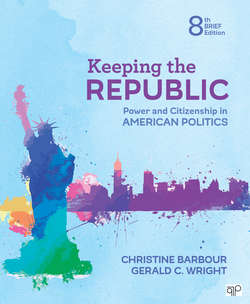Читать книгу Keeping the Republic - Christine Barbour - Страница 134
На сайте Литреса книга снята с продажи.
Applying the Bill of Rights to the States
ОглавлениеMost of the limitations on government action in the Bill of Rights are directed toward Congress. “Congress shall make no law . . . ,” begins the First Amendment. Until about the turn of the twentieth century, the Supreme Court clearly stipulated that the Bill of Rights applied only to the national government and not to the states.11
Not until the passage of the Fourteenth Amendment in 1868 did the Supreme Court have a tool to require that states protect their citizens’ basic liberties. That post–Civil War amendment was designed specifically to force southern states to extend the rights of citizenship to African Americans, but its wording left it open to other interpretations. The amendment says, in part,
No state shall make or enforce any law which shall abridge the privileges and immunities of citizens of the United States; nor shall any state deprive any person of life, liberty, or property, without due process of the law; nor deny to any person within its jurisdiction the equal protection of the laws.
In 1897 the Supreme Court tentatively began the process of selective nationalization, or incorporation, of most (but not all) of the protections of the Bill of Rights into the states’ Fourteenth Amendment obligations to guarantee their citizens due process of the law.12 But it was not until the case of Gitlow v. New York (1925) that the Court reversed almost a century of ruling by assuming that some rights are so fundamental that they deserve protection by the states as well as the federal government.13 This was a clear shift of power from the states to the national government to determine what rights states had to protect, a shift that came as it so often does at the hands of the Supreme Court. But it did not at first mean that all rights necessarily qualified for incorporation; the Court had to consider each right on a case-by-case basis to see how fundamental it was. Over the years, almost all the rights in the first ten amendments have been incorporated (see Table 4.1).
incorporation the Supreme Court action making the protections of the Bill of Rights applicable to the states
Keep in mind that since incorporation is a matter of interpretation rather than an absolute constitutional principle, it is a judicial creation. Like all other judicial creations, the process of incorporation is subject to reversal if the justices change their minds or if the composition of the Court changes, and it is possible that such a reversal may currently be under way as today’s more conservative Court narrows its understanding of the rights that states must protect.
Table 4.1
In Your Own Words
Explain how the Bill of Rights relates to the federal government and to the states.
